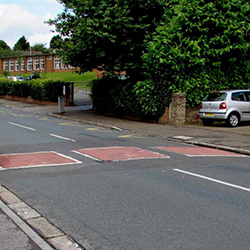Speed bumps are essential tools for traffic calming, designed to slow vehicles in areas where pedestrian safety is a concern. The standard height for speed bumps is typically between three to six inches, while the width can vary from one to three feet. These dimensions are crucial for ensuring that the speed bumps effectively reduce vehicle speeds without causing damage to vehicles or discomfort to drivers.
When considering the installation of speed bumps, it’s important to note the following:
- The height should be sufficient to slow down vehicles but not so high as to cause damage.
- The width must be wide enough to cover the lane of traffic but should allow for clearance at the edges.
- The spacing between speed bumps should be consistent to create a predictable driving environment.
Low-Profile Speed Bump Options
Low-profile speed bumps are an alternative to traditional models, designed to slow down vehicles without causing excessive discomfort or damage to the vehicle. These bumps are typically shorter in height, making them a suitable choice for areas with a high volume of low clearance vehicles, such as sports cars or vehicles with heavy loads. Key features of low-profile speed bumps include:- Reduced height, often not exceeding 2.25 inches
- A smoother transition for vehicles, minimizing the risk of undercarriage damage
- Compatibility with various installation methods, such as bolting down or gluing to the surface
Considerations for Drainage and Curb Design
Proper drainage is crucial to prevent water accumulation around speed bumps, which can lead to premature deterioration and pose a hazard to vehicles. When designing and installing speed bumps, engineers must ensure that water can flow freely around these structures to avoid creating puddles that could affect both the durability of the speed bump and the safety of the road. Key considerations for drainage and curb design include:- The slope of the road: Speed bumps should be placed in a way that complements the existing road grade, allowing water to drain naturally.
- Drainage systems: Additional drainage solutions, such as grates or channels, may be necessary to facilitate water runoff, especially in areas with heavy rainfall.
- Curb integration: The design of the speed bump should integrate seamlessly with the curb to prevent water from pooling at the edge of the road.
Community Impact and Public Perception
Balancing Safety with Convenience
When integrating speed bumps into roadways, the primary goal is to enhance safety for pedestrians and motorists. However, it’s crucial to strike a balance that doesn’t excessively impede traffic flow or cause unnecessary inconvenience.- Safety: Speed bumps are effective in reducing vehicle speeds, which can significantly decrease the likelihood of accidents and injuries.
- Convenience: Excessive use or poorly designed speed bumps can lead to driver frustration, increased travel time, and potential damage to vehicles if not properly navigated.
Gathering Community Feedback
Incorporating community feedback is a critical step in the implementation of speed bumps. Residents and local businesses are directly affected by these traffic calming measures, and their insights can lead to more effective and accepted solutions.- Conduct surveys to gauge public opinion.
- Hold town hall meetings for open discussions.
- Set up a suggestion box for anonymous contributions.
Case Studies: Speed Bump Implementation Success Stories
The strategic placement of speed bumps has proven to be an effective measure in enhancing road safety across various settings. One notable success story involves a university campus, where the introduction of road humps significantly reduced vehicle speeds, contributing to a safer environment for pedestrians and cyclists alike.- The study titled ‘Evaluating the Effectiveness of Road Humps in Reducing Vehicle Speeds’ highlighted the positive impact of these traffic calming devices.
- Field observations confirmed the reduction in speed, showcasing the practical benefits of well-designed speed bumps.

